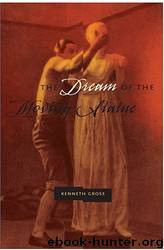The Dream of the Moving Statue by Kenneth Gross

Author:Kenneth Gross [Gross, Kenneth]
Language: eng
Format: epub
Tags: General, Art, Psychology, Popular Culture, Psychological aspects, Arts, Applied Psychology, Sculpture & Installation, Sculpture, Arts - Psychological Aspects, Statues, Personification in Art, Statues - Psychological Aspects, Sculpture - Psychological Aspects, Fantastic; The
ISBN: 9780271029009
Google: U7Ibqqgne_gC
Amazon: 0271029005
Publisher: Penn State Press
Published: 1992-01-02T00:00:00+00:00
To bring the dilemma out here, we might consider the parable about a secular fall from grace offered in Heinrich von Kleist's " On the Marionette Theatre." It is the story of a young man who, seated and drying himself off at a public bath, catches sight of himself in a mirror and finds that he has inadvertently assumed the pose of the famous ancient statue called the Spinario, which shows a boy pulling a thorn from his foot (a plaster cast of which, we are told, can be found in many German museums). He remarks on this resemblance to an older friend (the narrator of the story, in fact), but as either a mockery or a test of the young man's narcissism, the latter pretends not to see it. At this point, the youth finds himself compulsively and unsuccessfully trying to repeat the effect by an act of will, producing ever more comic gestures in the process. Trapped by, but never quite coinciding with, the statue—itself an image of unselfconscious grace—the young man falls from contingent mirroring into a darker, more self-divided specularity; standing for days before a mirror, soon "like an iron net, an invisible and incomprehensible power enveloped the free play of his gestures." 5 It is as if he becomes the ghostly double of the lifeless statue, instead of the statue's being a double of him. He cannot bring the statue to life; rather, the statue brings him to affective death. He becomes himself like a bad copy of the plaster statue; he becomes the statue's marionette, as it were, a figure whose center of gravity is always moved by something outside itself. The shape of this identification is thus highly ambiguous. On the one hand, he submits himself to the statue, which he resembles only contingently; he allows his will to be preemptively shaped by an inhuman, if familiar, image. And yet it may seem as if there is built into that will, or the desire that shapes it, something that makes him complicit in his failure to match the image. Kleist's narrative offers no explicit fantasy of a magical statue, of course. Still, especially given the superstitious hyperbole in the phrase quoted above, that text may indicate something about the situation in which such a fantasy might emerge. As part of its ironizing of human self-consciousness, the text suggests especially the logic by which some dispossessing, alien motion can be imposed on a person by the statue (though often with that person's complicity), rather than such a motion's being imposed on the statue by a living person. It suggests the betrayals or misdirec
-132-
Download
This site does not store any files on its server. We only index and link to content provided by other sites. Please contact the content providers to delete copyright contents if any and email us, we'll remove relevant links or contents immediately.
Picasso by Gertrude Stein(1503)
Modeling the Head in Clay by Bruno Lucchesi(1477)
Auguste Rodin by Rainer Maria Rilke(1362)
Modelling and Sculpture by Albert Toft(1287)
Louise Nevelson by Laurie Wilson(1190)
The Parthenon Marbles by Christopher Hitchens(1149)
You Must Change Your Life by Rachel Corbett(1124)
Antony Gormley on Sculpture by Antony Gormley(1124)
Asmat Art by Dirk Smidt(1103)
The TAB Guide to DIY Welding : Hands-on Projects for Hobbyists, Handymen, and Artists by Jackson Morley(1089)
Greek Art by John Boardman(1084)
Modular Origami Polyhedra by Lewis Simon & Bennett Arnstein & Rona Gurkewitz(1063)
Origami Holiday Decorations by Florence Temko(1008)
Origami for Beginners by Florence Temko(1007)
The Animal Gazer by Edgardo Franzosini(983)
Spiral Jetta: A Road Trip through the Land Art of the American West (Culture Trails) by Erin Hogan(979)
The Autobiography of Benvenuto Cellini (Penguin Classics) by Benvenuto Cellini(972)
Metal Clay Jewelry: Projects. Techniques. Inspirations. by Louise Duhamel(958)
The Pagan's Cup by Fergus Hume(954)
